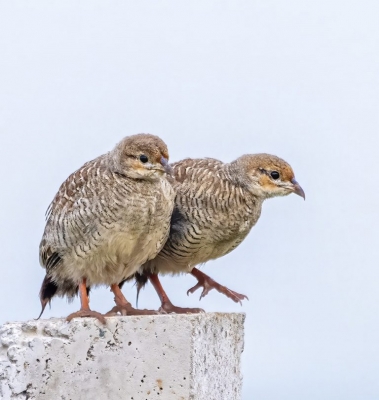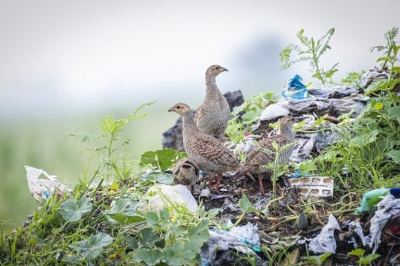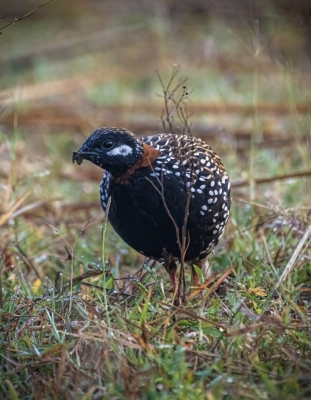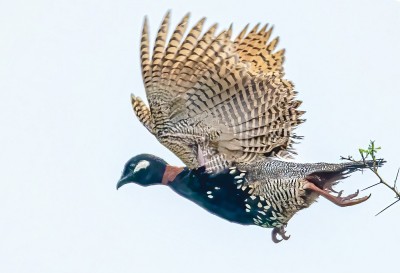

 BY Mrityunjoy Kumar Jha
BY Mrityunjoy Kumar Jha
New Delhi, Dec 21 : The partridge, well-known as a game bird is also hunted for meat. Called the partridge or English Partridge, it is native to the Indian continent and was introduced to the world for hunting and cuisine. Once upon a time, these birds were hunted for their meat but after the Wildlife Protection Act (WPA) 1972 it is illegal to catch, keep, kill, trade the partridges or even damage their nests.
Called the teetar in Hindi, it has a new name in English-Francolin, while the ‘bhura teetar’ is known as the grey francolin. India has a rich diversity of francolins found throughout the country. It is frequently spotted in places that offer thick vegetation as cover.
The grey francolin is an inseparable part of village life in India where monsoon mornings are filled with its relentless calls that sound like ‘ka-tee-tar-ka-tee-tar’. A seed-eating ground bird, the grey francolin can run so effortlessly that it looks like a stream gliding down a slope-which is how it disappears into shrubs at the slightest suspicion of threat.
Despite its camouflage and swiftness, humans manage to capture this bird for sport, meat and hunting. Incidentally, the first-ever time I saw the bird up close was in a village in West Bengal, where a man illegally kept a pair in a cage as pets. Perhaps it is this memory that gives me joy to see coveys of these lively birds rambling free in open plains, relatively easy to spot but with enough space to escape if threatened.
About the size of a small hen, they are rufous brown, with a light pale-biscuit basket-weave pattern across their bodies. They have a yellow throat patch and broken black-collar called a gular loop.
While grey francolins are smart, they have a knockout cousin, the black francolin, which saunters around the countryside in northern India. This fellow is jet black, stippled with gold, with vivid white cheek patches and wears a copper-coloured collar. He will stand on tiptoe and cheerfully call distinctive in its distinctive ‘klik cheek-cheek-cheerakik’ which my friends say sounds like “Paan-beedi-cigarette”.
Black francolins aren’t uncommon, in fact they are categorised under the ‘Least Concern’ status by the IUCN. They were abundant earlier till they got hunted excessively. Today, the black francolin is protected by law and also carries the crown of the state bird of Haryana. However, if there is one bird which has made me desperate, it is this one.
Their loud ringing calls can’t be mistaken and has often led me to spot them during their breeding season. One fine morning, it suddenly emerged from the bushes and began briskly walking in front of our car. We stopped the car, the bird also stopped but when we started clicking pictures, it took off. This chase went on for an hour till the little guy vanished into the bushes. After repeated misses, black francolin was the only species which I had completely ‘given up’ on.
As I mentioned in my previous post, one of the birds that made me exclaim ‘wow’ was the black francolin, a medium-sized ground bird belonging to the partridge family. Its stunning pitch-black coat with petals of gold, white and a beautiful red collar mesmerised me. It was reluctant to show off itself, giving me occasional glimpses of its beautiful self.
Patience pays. A week later we found him on the top of a tree shining in the early morning sunlight. The detailed patterns on its body and the various colours highlighted its beauty. Usually, francolin behave like fugitives on the run but that day it posed for us. This black francolin was indeed beautiful.
“The black francolin was commonly found in Haryana but it was hunted and faced a wide habitat loss. This state bird of Haryana is also found in Delhi and NCR due to its natural habitat. It is a very shy bird and its presence indicates that the ecosystem is in good health,” says our guide, Sube Singh. He adds that the villagers also are aware of this.
Ironically, both the birds face the same problem that has driven the common sparrow from the NCR: lack of habitat and overuse of pesticide, which decimates insects-their staple food base.
According to media reports, despite the ban on hunting of francolins, illegal poaching continues. Illegal sale of bird meat happens clandestinely in many parts of the country. In Pakistan, hunting of francolins is rampant and their meat is available in hotels at a premium.
In 2018, the media reported that cricketer-turned-politician Navjot Singh Sidhu got into trouble because of the gift he got from Pakistan-a masala-stuffed black francolin. Keeping the stuffed bird is illegal under the WPA as it invites a jail term upto three years or Rs 25,000 fine or both.
(This content is being carried under an arrangement with indianarrative.com)
Disclaimer: This story is auto-generated from IANS service.

